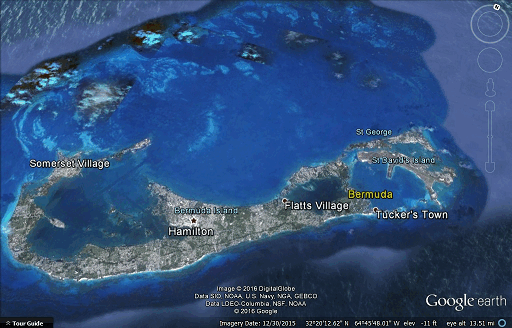|
The weather at Bermuda was cloudy, with a ragged top and a low haze layer. Low fog and rain storms were north off the coast, out several miles. The wind was a mild 10 knots.
Polly Alpha 4’s pilot Lt. Morris Larson signaled Kindley Field tower that the landing gear fully retracted and all was well. Radar confirmed he was 10 miles north of Kindley Field already.
Polly Alpha 5 and 6 had joined the leading three as Element. Together they waited for Larson to join up. Yet Polly Alpha 4 was nowhere to be seen. Nor did Lt. Larson contact them over the radio. The squadron tried to reach him. No answer. Kindley Field now tried, but there was no answer. Worry that he might have crashed was forestalled by the fact Kindley Field tower reported no radar target had indicated an aircraft had fallen to the ocean. His last position was 10 miles north of Kindley. Then there was nothing. One sweep of the scope and he was gone.
Randy 12, one of the rescue choppers, was on the way. The fog was dense over the area, with only 500 feet visibility. Occasional rain showers brought the visibility down to 300 feet. Randy 12 reported sighting nothing. Since radar had not detected the Starfighter crashing, it was thought possible that Larson had broken out above the clouds and was at high altitude.
The scramble alarm was hit at Kindley Field. More F-104s and a T-33 were launched. They angled up sharply and pierced through the overcast and clouds. They had one object– search for contrails. Yet none were seen. Several choppers scanned the sea for days. No trace was ever found.

Radar reported Larson right about where the clear area of the satellite photo blurs with the un-photographed area of the Bermuda Rise (10 miles north of Kindley field on St. David’s Island.) The Bermuda seamount is chalked with wrecks. It is a diver’s mecca. The carnage of the rough seas are everywhere. Somewhere this space age edition of wreckage should be found, but there was no hard evidence the Starfighter ever crashed.
The legend of the missing Starfighter says that it entered a cloud and did not come out. To some extent this is true. It entered the haze layer, the pilot reported all was well, and then he and his shiny silver jet vanished.
The utter lack of evidence inspired a high altitude search, but there was no trace anywhere of what happened to Morris Larson.
Somewhere below the shallow water of the Bermuda Rise his shiny silver flying rocket is supposed to be. But no one has yet reported it. Like so many others in the Triangle, the records say the wreckage should be here, but in fact it is not. . . .or to date has never been found.
|
